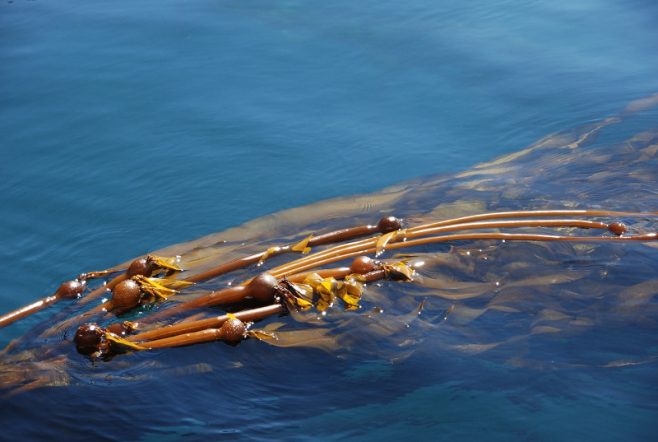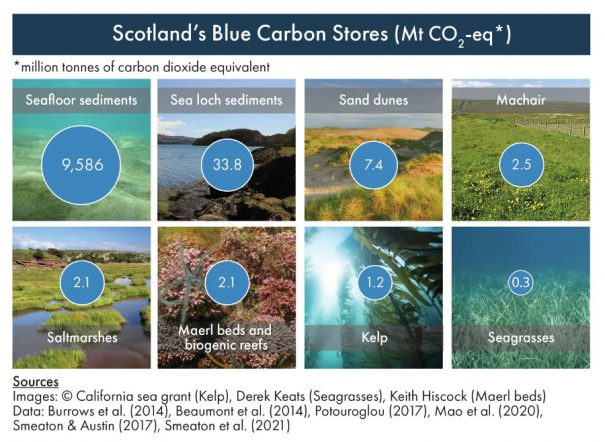
This blog from the Scottish Parliament Information Centre (SPICe) explains the current understanding of carbon captured and stored in Scotland’s coastal and marine environment, known as ‘blue carbon’. It also outlines known threats to blue carbon stores and explores opportunities for embedding blue carbon in Scotland’s climate change policy. The blog summarises a more in-depth SPICe briefing.
Blue Versus Green
In 2009, the term ‘blue carbon’ was coined to highlight the importance of marine and coastal environments in storing carbon and mitigating climate change. This branding aimed to bring attention to marine environments’ role in climate change mitigation in a policy landscape overwhelmingly focused on ‘green’ land-based carbon, such as forestry. Over a decade later, governments, non-governmental organisations and intergovernmental bodies recognise the importance of this in climate change mitigation – but policy still lags behind its green counterpart.
Scotland’s blue environment
The oceans store 93% of Earth’s carbon dioxide. Therefore, as a nation surrounded by the sea, blue carbon plays a central role in Scotland’s carbon storage and sequestration. Carbon taken up (sequestered) by Scotland’s living coastal and marine habitats (such as saltmarshes, sand dunes, seagrasses and reef-forming habitats) and geological sediments covering Scotland’s seafloor and sea lochs. In contrast, human activities and peatland environments give off carbon dioxide, contributing to Scotland’s greenhouse gas emissions and climate change.
Scotland’s marine environment stores more carbon than the terrestrial environment. This is perhaps unsurprising given that the total sea area is six times greater than the total area of land.
Scotland’s blue carbon stores have grown to their current magnitude by sequestering great quantities of carbon and storing it for millennia. Sediments on the seafloor sequester over 99% of Scotland’s blue carbon – which equates to a CO2-equivalent equal to almost two-thirds of Scotland’s annual greenhouse gas (GHG) emissions. Biological habitats (such as iconic maerl beds and flame shell beds) play a much smaller role in carbon sequestration and storage (< 0.2% of Scotland’s blue carbon) but provide rich contributions to biodiversity and climate change resilience.

Blue carbon under threat
The continued ability of habitats and systems to sequester and store carbon relies on their protection from key threats: physical disturbances, climate change and changes in land-use and land management. These threats can prevent ecosystems from sequestering carbon in the future and lead to the rapid release of carbon that has accumulated over millennia. This is especially true if habitats and stores are physically disturbed, for instance, by bottom-towed fishing or the installation of offshore energy infrastructure.
Therefore, without adequate protection, blue carbon habitats and stores may become future sources of carbon emissions. This is what happened with the carbon stored in peatlands. Peatlands have the potential to sequester and store vast quantities of carbon, but this potential has been impaired by historical damage, and as such, an estimated 80% of peatlands are in a degraded condition.

Climate Change Plan
Scotland’s current climate change strategies focus on supporting green carbon ecosystems –forestry and peatland – on the pathway towards net-zero. Scotland’s Climate Change Plan (CCP), published in 2018 and the 2020 draft update (CCPu), set out to restore 250,000 hectares of degraded peatland and increase forest cover by 21% by 2032 (more on this in a previous blog post).
In contrast, the CCP and CCPu do not outline any policies to protect or enhance blue carbon stores. However, the Scottish Government has committed £570,000 to the establishment of the Scottish Blue Carbon Forum to support research and inform policymaking. The CCPu further draws attention to Scotland’s upcoming ‘Blue Economy Action Plan’:
“We are also developing Scotland’s Blue Economy Action Plan, which will provide leadership through collaboration and innovation, maximising the impact of public investment and developing better regulation to help manage the shared use of the seas by Scotland’s marine sectors, communities and ecosystems. We will optimise opportunities to unlock the significant inclusive growth potential of Scotland’s marine space whilst supporting a transition to net zero.”
Protecting Blue Carbon
During parliamentary scrutiny of the CCPu, the Environment, Climate Change and Land Reform (ECCLR) committee heard evidence of research emerging from the Scottish Blue Carbon Forum highlighting ‘hotspots for carbon burial’ in Scotland’s seas. Based on this evidence, the ECCLR committee recommended that the Scottish Government:
- Brings forward policies on how to protect blue carbon stores through the forthcoming update of the National Marine Plan and the development of the Blue Economy Action Plan and reflects this intention in the final CCPu.
- Provides clear guidance on the role of spatial management in protecting blue carbon hotspots from pressures such as mobile bottom-contacting fishing gear.
- Ensures that storage and sequestration capacity is taken into account in proposals for management measures in Marine Protected Areas.
- Provides further information on how it will ensure that the Blue Economy Action Plan reconciles the need to ensure protection of natural capital such as blue carbon and marine biodiversity hotspots with socioeconomic priorities of coastal communities.
Marine Protected Areas
The ECCLR recommendations reflect evidence heard that there are already opportunities for protection through Scotland’s Marine Protected Area (MPA) network. These opportunities are based within the Marine (Scotland) Act 2010 and the Marine and Coastal Access Act 2009, which provide powers for Scottish Ministers to designate Marine Protected Areas (MPAs) based on their contribution to climate change.
Some habitats are already protected by MPAs, due to their contribution to Scotland’s biodiversity, such as the 1.85 km2 flame shell bed in Loch Carron. To date, no MPAs have been designated solely on their role in climate change mitigation – and there is no evidence that climate change has been considered in current and proposed MPA designation.
What next for Blue Carbon?
A growing body of evidence emerging from the Scottish Blue Carbon Forum and wider research shows that Scotland’s marine and coastal environment contributes more significantly to carbon storage than the terrestrial environment. Yet policies and proposals on protection, with regard to climate change mitigation, remain under-developed with comments from the ECCLR committee that it is moving at a ‘slower pace’ compared with peatland policy.
This raises the question – particularly considering the urgency of the climate crisis – whether the pace of policy is moving fast enough. This question touches upon a universal challenge in making evidence-led policy – at what point can the scientific evidence base be deemed sufficient to implement policy?
COP26, the UN’s Climate Change Conference of the Parties being hosted in Glasgow in November (COP26), will be a key opportunity to increase the momentum of blue carbon within climate change policy. Alongside COP26, a Scottish Blue Carbon Conference will showcase Scotland’s latest blue carbon research, best practice and emerging opportunities for blue carbon policy, underpinned by a focus on evidence-led policy.
This year the Fifteenth meeting of the Conference of the Parties to the Convention on Biological Diversity (COP15) will also take place in Kunming, China and provides a further opportunity to raise the profile of blue carbon, considering the contribution of relevant habitats and species to global biodiversity.
This blog was authored by Roxana Shafiee: Environment, Rural, Constitution and International Research and originally posted as Out of the blue: Is blue carbon the next frontier for climate change mitigation in Scotland? at the SPICe website.
Tags: Blue Carbon, Climate change, Policy, Protected-Areas